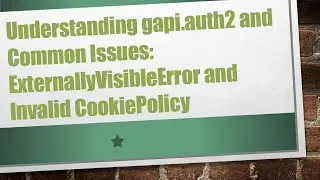Resolving the Bad Request Error in HTTP.NET POST Requests
Learn how to troubleshoot and fix `Bad Request` errors when sending POST requests using HTTP.NET with clear examples and best practices.
---
This video is based on the question https://stackoverflow.com/q/73066131/ asked by the user 'MadElephant' ( https://stackoverflow.com/u/17457317/ ) and on the answer https://stackoverflow.com/a/73066313/ provided by the user 'AlanK' ( https://stackoverflow.com/u/1848953/ ) at 'Stack Overflow' website. Thanks to these great users and Stackexchange community for their contributions.
Visit these links for original content and any more details, such as alternate solutions, latest updates/developments on topic, comments, revision history etc. For example, the original title of the Question was: The body I am send through as a POST request gives me a bad request, where am I going wrong using HTTP.NET
Also, Content (except music) licensed under CC BY-SA https://meta.stackexchange.com/help/l...
The original Question post is licensed under the 'CC BY-SA 4.0' ( https://creativecommons.org/licenses/... ) license, and the original Answer post is licensed under the 'CC BY-SA 4.0' ( https://creativecommons.org/licenses/... ) license.
If anything seems off to you, please feel free to write me at vlogize [AT] gmail [DOT] com.
---
Resolving the Bad Request Error in HTTP.NET POST Requests
When working with HTTP requests in C-, encountering a Bad Request error can be frustrating. This error typically indicates that the server cannot process the request due to a client error, which could stem from issues such as malformed request syntax or invalid request parameters. In this guide, we will address a common scenario where a Bad Request error occurs during a POST request with HTTP.NET and provide a detailed solution.
Understanding the Problem
You might run into a Bad Request error if the body you're sending with your POST request is not formatted correctly. In the case discussed, the code involves serializing an already serialized JSON string, which leads to incorrect request content. Let's break down the provided code snippet and identify the source of the issue.
Common Code Structure for POST Requests
[[See Video to Reveal this Text or Code Snippet]]
In this example, body reads JSON content from a file, and then JsonConvert.SerializeObject(body) is used, which essentially serializes a string again, causing an invalid payload that can lead to the Bad Request error.
The Solution
To resolve the issue, we should avoid re-serializing the JSON string. Instead, use the JSON string directly. Here's how you can fix it:
Revised Code Example
[[See Video to Reveal this Text or Code Snippet]]
By directly assigning the content read from the file to the request message, you ensure that the body being sent to the server is already properly formatted as JSON.
Why This Works
Avoid Double Serialization: The original code mistakenly serialized an already serialized JSON string, converting it into an invalid format. By directly using the string, you ensure that the payload remains valid.
Simplification: The revised code removes unnecessary complexity, improving maintainability and clarity.
Additional Best Practices
Testing Different Inputs: Always test with various inputs to ensure your solution is robust and handles edge cases.
Logging Errors: Implement error logging to better understand why requests fail and to make debugging easier in the future.
Conclusion
Submitting a Bad Request error when making POST requests in HTTP.NET can be due to improperly structured payloads. By understanding the cause of the error and applying the solution outlined in this guide, you can get past this hurdle in your development work. Always remember to check your serialized data and ensure that the format matches the expected input of the server.
We hope this information proves helpful for your future HTTP requests! Happy coding!































